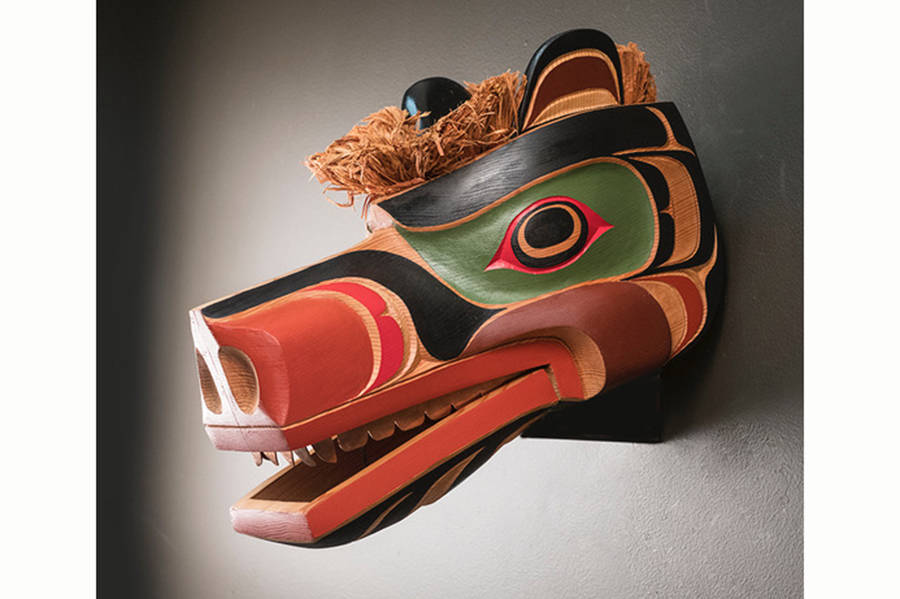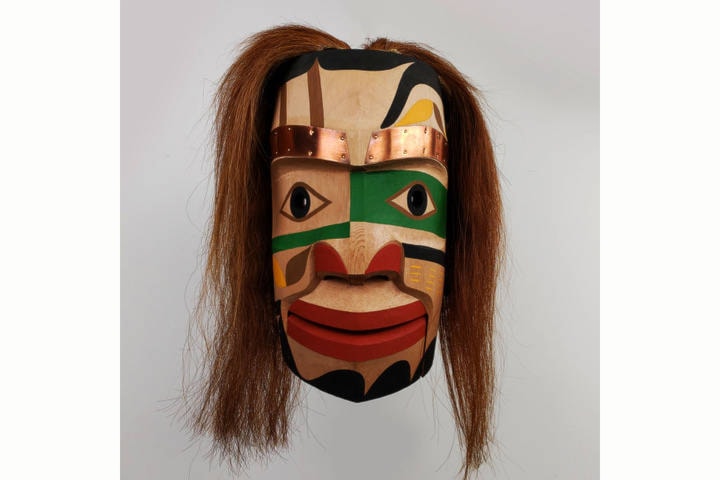By Carol Sheehan
Special to The Record
I’TUSTO—Rising Again is an exhibition of works by internationally renowned Kwagu’ł artist Calvin Hunt at Spirits of the West Coast Art Gallery, at 2926 Back Road, Courtenay.
Calvin Hunt purposely selected the title for the show.
“As our culture evolves again, it’s coming back more and more,” he said. “Our young people seem to be becoming more involved. Unfortunately, we’ve lost so many of our elders; there’s not many left. So, a lot of the young people are assuming their positions now.
“I think in the early ’80s, we were so dependent on our old people, we never thought that they were going to leave us, and then all of a sudden they were all gone. It didn’t look good for a while. And then it was just a few young people who stepped in and got it going again—and it just blossomed from there. To me, that means we’re rising up again. It’s been an ongoing process for a long time.”
I’TUSTO is more than a fine art exhibition. It has a storyline that celebrates a history of cultural ideas that provides both an aesthetic experience and an educational one. While it brings fresh insights to Hunt’s life-long commitment to the continuity and diversity of his cultural heritage, I’TUSTO offers opportunities to learn more about the finer cultural aspects of Northwest Coast First Nations through the eyes of Hunt, artist and knowledge keeper.
Hunt’s great-great-grandmother, Anisalaga, Mary Ebbetts Hunt, was a Tlingit noblewoman from Klinkwan, Alaska. She brought with her the tradition and rights to weave Chilkat dancing blankets and regalia worn by prominent people for important ceremonies. Calvin’s grandfather was the renowned Kwakwaka’wakw carver Chief Mungo Martin, and his grandmother, Abayah, was also a Chilkat weaver.
Youngest son
Calvin is the youngest son of Kwagu’ł Hereditary Chief Thomas Hunt and his wife Maxwalaogwa, Emma Hunt, the Nuu-chah-nulth daughter of the great Mowachaht Chief and Shaman, Dr. Billy from Yuquot, Friendly Cove. Descended from these distinguished families, Calvin’s Kwagu’ł name is Chief Tłasutiwalis and his Mowachaht name is Hereditary Chief Nas’a̱m’yus.
With such a diverse ancestry, Hunt has created works for this exhibition that take us inside the spirituality and ceremony of his Kwakwakaʼwakw, Tlingit and Nuu-chah-nulth cultural inheritance. Tall dance wands, a Chilkat dancing robe pattern board, and ceremonial hats are inspired by his Tlingit forebearers. His Mowachaht connection is reflected in a large Nuu-chah-nulth Land Chief mask with its copper eyebrows and moveable jaw. Many visitors may be surprised to encounter a massive Kwakwakaʼwakw ridicule figure with a dual cultural reference. Its explicit female form recounts the past practice of shaming a rival chief, while the painted designs on her body honour the continuing tradition of respect and honour for all Kwakwakaʼwakw women who are the ‘chief makers.’
Worldwide recognition
Hunt’s reputation for authenticity and artistic excellence spans the globe. Public and private collectors from Europe, Canada and the United States have collected his work of totem poles and masks. His monumental sculptures in wood, stone and bronze, his canoes, his masks and ceremonial regalia, his serigraphs, his gold and silver jewellery, and his performance art have garnered international appreciation. Hunt has developed a unique niche for himself in creating dance costumes; he has made about a dozen of them and they are in museum collections around the world.
His art has been shown in major exhibitions in Canada, the United States, Germany, Indonesia, and Japan. His poles are celebrated throughout the world and in many B.C. centres.
Since 1989, most of the Comox Valley’s beautiful totem poles were carved by Calvin Hunt.
He replicated the famous Mungo Martin poles that flank the entrance to Lewis Park. He carved the stunning pole in the centre of the Comox Valley Airport roundabout, the poles at Courtenay Elementary School, Comox Marine Park, the front of the I-Hos gallery, and the Puntledge RV Campground. His most recent monumental sculptures—two house front poles on the K’ómok’s First Nation’s administration building—celebrate the four major families of that nation.
Hunt’s art crosses the continuum of history to the present. Inducted into the prestigious Royal Academy of Arts in 2004, he was also honoured with the BC Creative Achievement Award for Aboriginal Art in 2009.
Working within traditional Northwest Coast Kwagu’ł style, he is constantly reminded of and conveys continuity in the history of ideas in Kwakwaka’wakw culture —ideas about diversity, spirituality, transformation, honour, respect, and meaning.
“The subject, design elements and colours are elements that contribute to my inspiration,” he writes. “There are certain elements that represent the unifying symbolism of various animals and legends which I follow through the knowledge and teachings of my chiefs, elders and artists.”
Hunt has embraced the traditional role of teaching carving to others. Under his mentoring, younger First Nations artists have learned not only the traditional forms and elements of Northwest Coast Kwagu’ł style, but they have been taught the continuity in the history of ideas in Kwakwaka’wakw culture—ideas about diversity, spirituality, transformation, honour, respect, and meaning.
Special guest artist
With a special invitation from Calvin Hunt, Karver Everson is included in the I’TUSTO exhibition.
“I think Karver is really enthusiastic about learning not only about how to carve, but about the culture as well, about protocols and things like that,” Hunt said. “Some guys just want to carve because they want to become famous or whatever. It doesn’t really work like that. It takes a lifetime to establish yourself, your name. So, I thought he would be a good candidate to involve in this show as well.”
Born in Comox, Karver was named Gayustistalas—a name that once belonged to his father, Chief Rob Everson of the Gigalʼgam Walas Kwagu’ł from the Kwakwakaʼwakw People. Greatly influenced by his family connection to their heritage, which reflects the cultural traditions of both K’ómoks and Kwakwakaʼwakw ancestors, Karver has created six dance masks and headdresses to hang alongside Hunt’s in an exceptional pairing of master and mentee.
Under Hunt’s mentorship, Everson and Randy Frank both worked on the two crest poles that flank the façade of the K’ómoks administration building.
“When you work with someone who has perfected their craft, you’re just in awe of their skill and ability,” Karver says, of this first-time experience working on large poles. “It’s almost as if they do it by magic. That’s how I felt working with Calvin. I was in awe of how he could look at the log, start making cuts, and reveal what he envisioned within it.
“He’s someone I consider a master. A master carver is not only a skilled artist and craftsman, but also holds himself in a really good way. They’re humble, kind and help their family and the next generation, and they do a lot for their culture. I’ve learned so much from Calvin. I’m grateful for all the work we’ve done together and the knowledge he’s passed on to me.”
Karver and Randy have gone on to create four new poles in the Comox Valley — again with Calvin’s guidance. They are two Guardian poles on K’ómoks First Nation territories of Goose Spit and the Puntledge River Campground. In 2018 two additional poles were raised in front of the Comox Valley Art Gallery, marking the first time in living memory that K’ómoks poles have been raised in the City of Courtenay.
I’TUSTO—Rising Again is an apt title for an exhibition that celebrates the growth of First Nations cultural strength through art, language, identity, ceremony and knowledge sharing.
“I enjoy sharing our culture with the world, and I feel very fortunate to have the capacity to pass on our Elders’ teachings,” said Hunt, from his Copper Maker Gallery in Fort Rupert.
This inspiring exhibition and sale opens in an innovative virtual format on Facebook at 1 p.m. on Saturday, Sept. 5, with live-streamed celebratory songs and dances by Calvin Hunt’s Copper Maker Dancers.
In the on-line gallery tour of the exhibition, virtual audiences will have a unique opportunity to experience each artwork in I’TUSTO. Members of the public are also invited to visit the exhibition in person at 2926 Back Road, Courtenay, B.C.; the gallery maintains current pandemic response protocols. Visit the website at www.spiritsofthewestcoast.com and follow them on Facebook @spiritsofthewestcoast, Instagram @spiritsofthewestcoast and Twitter @spiritsgallery for the latest news, artist talks, and exhibition features.




